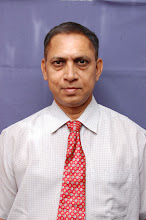Throughout the history of mankind spiritual giants have appeared on very rare occasions to exemplify the Highest Truth, guiding followers by their conduct in every moment of their lives; Bhagavan Sri Ramana Maharshi was such a giant. Unique in our time, He perfectly embodied the ultimate truth of Self-realisation, or complete absorption in the Supreme Itself.
Sri Ramana maintained that the purest form of his teachings was the powerful silence which radiated from his presence and quieted the minds of those attuned to it. He gave verbal teachings only for the benefit of those who could not understand his silence.[3] His verbal teachings were said to flow from his direct experience of Consciousness as the only existing reality.[4] When asked for advice, he recommended self-enquiry as the fastest path to moksha. Though his primary teaching is associated with Non-dualism, Advaita Vedanta, and Jnana yoga, he highly recommended Bhakti, and gave his approval to a variety of paths and practices
Teachers in his tradition
He considered his own guru to be the Self, in the form of the sacred mountain Arunachala. Sri Ramana did not publicize himself as a guru, never claimed to have disciples, and never appointed any successors. While a few who came to see him are said to have become enlightened through association, and there are accounts of private acknowledgements, he did not publicly acknowledge any living person as liberated other than his mother at death. Sri Ramana declared himself an atiasrama[47](beyond all caste and religious restrictions, not attached to anything in life), and did not belong to or promote any lineage. Despite his non-affiliations,[48] there are numerous contemporary teachers who publicly associate themselves with Sri Ramana, and some who assert being in his lineage.
His method of teaching was characterized by the following:
He urged people who came to him to practice self-enquiry;
He directed people to look inward rather than seeking outside themselves for Realization. ("The true Bhagavan resides in your Heart as your true Self. This is who I truly am.");
He viewed all who came to him as the Self rather than as lesser beings. ("The jnani sees no one as an ajnani. All are only jnanis in his sight.");
He charged no money, and was adamant that no one ever ask for money (or anything else) in his name;
He never promoted or called attention to himself. Instead, Sri Ramana remained in one place for 54 years, offering spiritual guidance to anyone of any background who came to him, and asking nothing in return;
He considered humility to be the highest quality;
He said the deep sense of peace one felt around a jnani was the surest indicator of their spiritual state, that equality towards all was a true sign of liberation, and that what a true jnani did was always for others, not themselves.
Sri Ramana maintained that the purest form of his teachings was the powerful silence which radiated from his presence and quieted the minds of those attuned to it. He gave verbal teachings only for the benefit of those who could not understand his silence.[3] His verbal teachings were said to flow from his direct experience of Consciousness as the only existing reality.[4] When asked for advice, he recommended self-enquiry as the fastest path to moksha. Though his primary teaching is associated with Non-dualism, Advaita Vedanta, and Jnana yoga, he highly recommended Bhakti, and gave his approval to a variety of paths and practices
Teachers in his tradition
He considered his own guru to be the Self, in the form of the sacred mountain Arunachala. Sri Ramana did not publicize himself as a guru, never claimed to have disciples, and never appointed any successors. While a few who came to see him are said to have become enlightened through association, and there are accounts of private acknowledgements, he did not publicly acknowledge any living person as liberated other than his mother at death. Sri Ramana declared himself an atiasrama[47](beyond all caste and religious restrictions, not attached to anything in life), and did not belong to or promote any lineage. Despite his non-affiliations,[48] there are numerous contemporary teachers who publicly associate themselves with Sri Ramana, and some who assert being in his lineage.
His method of teaching was characterized by the following:
He urged people who came to him to practice self-enquiry;
He directed people to look inward rather than seeking outside themselves for Realization. ("The true Bhagavan resides in your Heart as your true Self. This is who I truly am.");
He viewed all who came to him as the Self rather than as lesser beings. ("The jnani sees no one as an ajnani. All are only jnanis in his sight.");
He charged no money, and was adamant that no one ever ask for money (or anything else) in his name;
He never promoted or called attention to himself. Instead, Sri Ramana remained in one place for 54 years, offering spiritual guidance to anyone of any background who came to him, and asking nothing in return;
He considered humility to be the highest quality;
He said the deep sense of peace one felt around a jnani was the surest indicator of their spiritual state, that equality towards all was a true sign of liberation, and that what a true jnani did was always for others, not themselves.
I am a follower of Bhagawan Sri Ramana Maharishi as I found him to be a unique person whose life history is to be read and eschewed by every one who has a belief in himself.
I am open to have discussions and exchange Ideas with all my Group members who have questions and looking for answers.
S.Sekar

No comments:
Post a Comment